Predock Frane Architects:
Hadrian Predock, John Frane, Principals
Chris Schoeneck, Johanna Beuscher, Heinrich Huber, Design Team
Designed for Site #3 in Abu Dhabi, near Masdar City.

Design Submission for the 2010 Land Art Generator Initiative Design Competition
Third Place Mention from the Jury
Artist’s descriptive text:
SOLARIS – Predock + Frane
Critically engaging the emerging Abu Dhabi context of Masdar City, Zayed University and other tabula rasa territories, our project proposes an antidote and refuge to the frenetic future-scape internationalism of the rapidly developing Arabian coast. In proposing a new abstract art space that allows for escape and contemplation our project positions itself as a hybrid landscape/environmental machine that can both deliver power and engage the radical phenomenon of the desert. Along a path connecting Masdar City to Zayed University, a low-slung, energy producing sensitive field beckons public engagement.
Our proposal for the Land Art Generator Initiative on the Masdar adjacent site is conceived as a sensitive draping tissue whose shape responds to the local natural forces of the Arabian Desert, while simultaneously acting as a phenomenological instrument that engages and reveals the power and subtlety of desert light and surface. Like the woven hair of a Bedouin “black tent”, a field of intelligent solar modules form a veil that covers the entire site. Sometimes acting as landscape, sometimes as spatial enclosure, the solar units undulate across the site forming a deeply considered pattern of responses to wind, sun, night sky and pathways. Mirroring the blanket of reflective modules, the geometrically patterned ground plane of sand and water further defines the site and engages in specific environmental response.
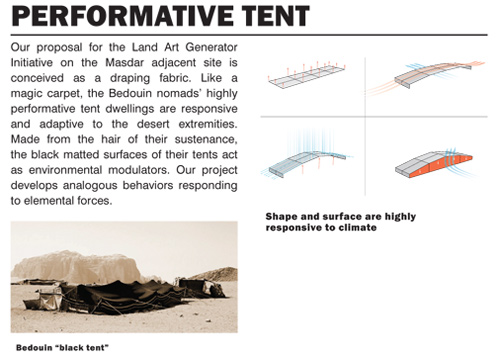
Seeking analogs specific to the Arabian Desert, our project conceptually weaves together behavioral traits of the desert ecology into our designed fabric. Research into both the human constructed and the naturally occuring yields a wide and deep field of understanding. The nomadic Bedouins (who perceive themselves as the original Arab tent dwellers) have an intimate relationship with both the landscape and their herds of goats. Like a magic carpet, their performative tent dwellings are highly responsive and adaptive to the desert extremities. Made from the hair of their sustenance, the black matted surfaces of their tents act as environmental modulators. Under different climatic conditions, the porosity of the woven hair either opens or closes. In the desert landscape, the formation of dunes demonstrates a “power by numbers” dance between particles of sand and wind where accumulated quantity achieves an overall coherent quality. The dunes are dynamic organisms that never have a fixed form and travel in packs as mobile landscapes.
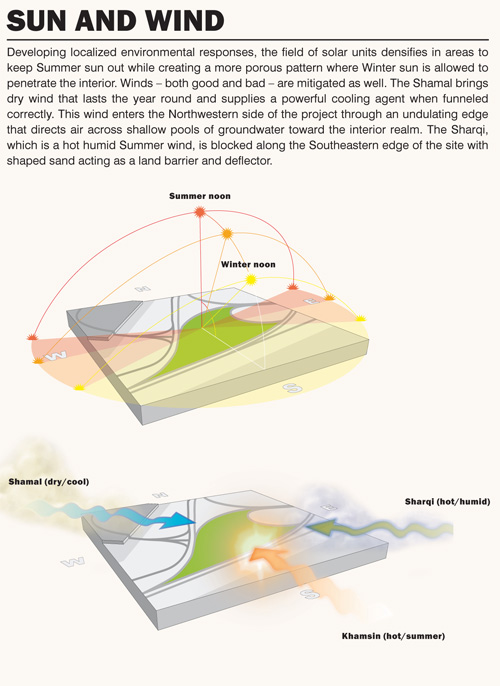
Our project behaves in ways similar to both the Bedouin tent and the sand dune, actively deploying a simple module (Cool Earth solar balloon) in quantities that allow for a range of specific behaviors. As an analogous “black tent” operating on an enormous scale, our proposal finds its morphology by synthesizing together both energy optimization, environmental behaviors and atmospheric effects. Beginning with a field of Cool Earth inflatable solar units on a grid oriented to the ideal solar angle (South), the basic carpet of modules is pulled off the ground to a crescendo in the middle of the site targeting on the North Star – Polaris, the ultimate point of orientation within a landscape free of points of reference. Developing localized environmental responses, the field of solar units densifies in areas to keep Summer sun out while creating a more porous pattern where Southern Winter sun is allowed to penetrate the interior. Winds – both good and bad – are mitigated as well. The Shamal brings dry wind that lasts the year round and supplies a powerful cooling agent when funneled correctly. This wind conditions the Northwestern side of the project forming an undulating edge that directs air across shallow pools of groundwater toward the interior realm. The Sharqi, which is a hot humid Summer wind, is blocked along the Southeastern edge of the site with shaped sand acting as a land barrier and deflector. These responses in coordination with each other form a sensitive, responsive tissue.
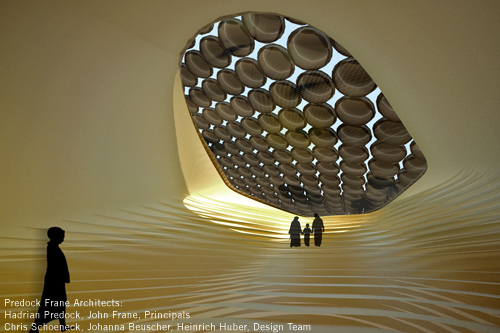
Phenomenologically, the project seeks a larger engagement with time, revealing and engaging light and matter – a sensate realm where one is allowed to simply feel and experience the slowness and power of the desert. In this regard, the field of modules acts as a surrogate reflective sky with heightened adjustments toward specific views. It also creates a pattern of dappled light that emanates from the environmentally induced responses. The underside of the solar modules are a reflective black sheen that mirrors the surface of the patterned ground matrix of water and sand, drawing heat up and out of the interior volume.
A tunneling path that stems from vital transportation hubs, links Masdar City across our site to Zayed University. Entering from Masdar, one descends into the ground within an orchard of date palms, tunnels through the earth inside a ribbed body, and emerges within the abstracted interior volume. The ground plane is a geometricized patchwork of sculpted dunes and excavated pools of groundwater. The sand of the ground is evenly cut and filled throughout the site, creating a large berm along the Southeast edge combating the harsh Sharqi wind. This artificially natural groundscape merges with the canopy of solar modules along the perimeter of the site forming a unified solar landscape.
Power Generation
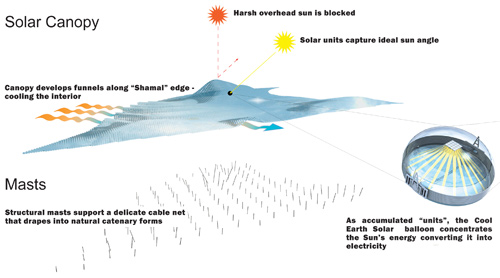
Working collaboratively with Cool Earth, producers of a new breed of high concentration solar modules, our project deploys an ingenious new breed of solar technology. Eliminating the metal content and material weight of traditional flat solar panels with air and recyclable plastics, the Cool Earth module takes into consideration the Cradle to Cradle carbon footprint thinking of the entire lifecycle. Using inexpensive and free materials, the balloon-like solar unit makes cost and efficiency its modus operandi. A curved, mirrored, mylar surface is designed to concentrate the sun’s rays of energy onto a cell of highly efficient photovoltaic material. The concentrated cell produces around 300-400 times the energy than that of a conventional cell. With close to 25,000 solar cells the Solar Canopy will produce on average 73,000 megawatt-hours per year – enough to power the country of Chad for a year. The soft curvaceous underbelly of the combined units makes for a sensuous undulating surface that contains the indoor-outdoor spaces below. Structurally, a mast and cable system like a tent will create a tensile cable net that the solar units are suspended within. Like a field of sunflowers the Cool Earth units will track the sun angle, optimizing energy gain.
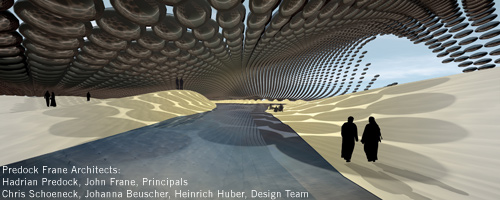
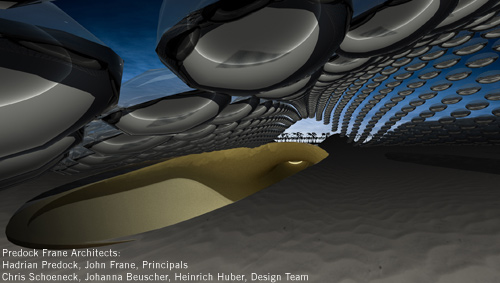

While the power generation is largely to benefit that which exists beyond our site, part of the energy produced is reserved for the benefit of the artwork. Hardworking and absorptive during the day, at night, a slow and unfolding wash of delicate colored light contrasts with the starry heavens across the canopy underside.
Related Posts
1 Comment
Add comment Cancel reply
This site uses Akismet to reduce spam. Learn how your comment data is processed.

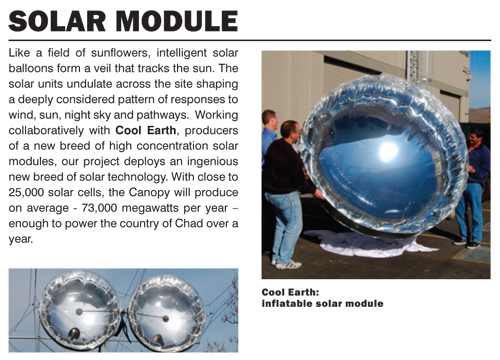
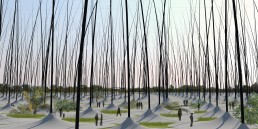
[…] place mention: Solaris, Hadrian Predock, John Frane (principals) and Chris Schoeneck, Johanna Beuscher, Heinrich Huber […]